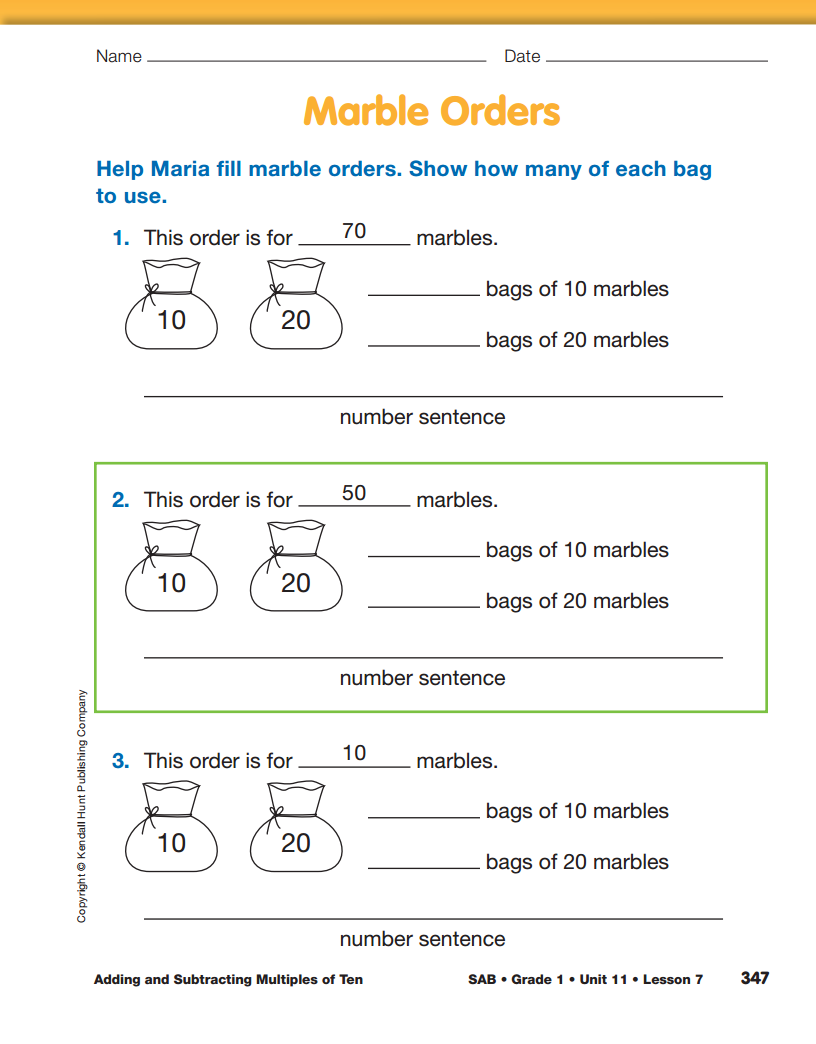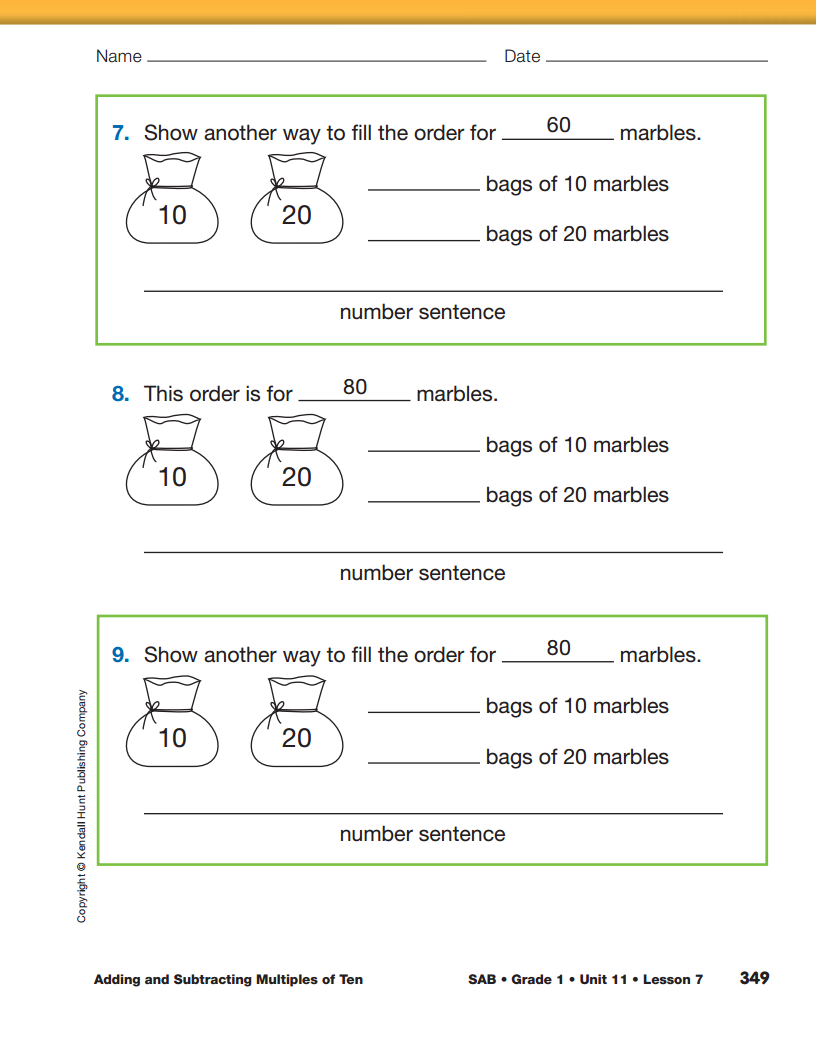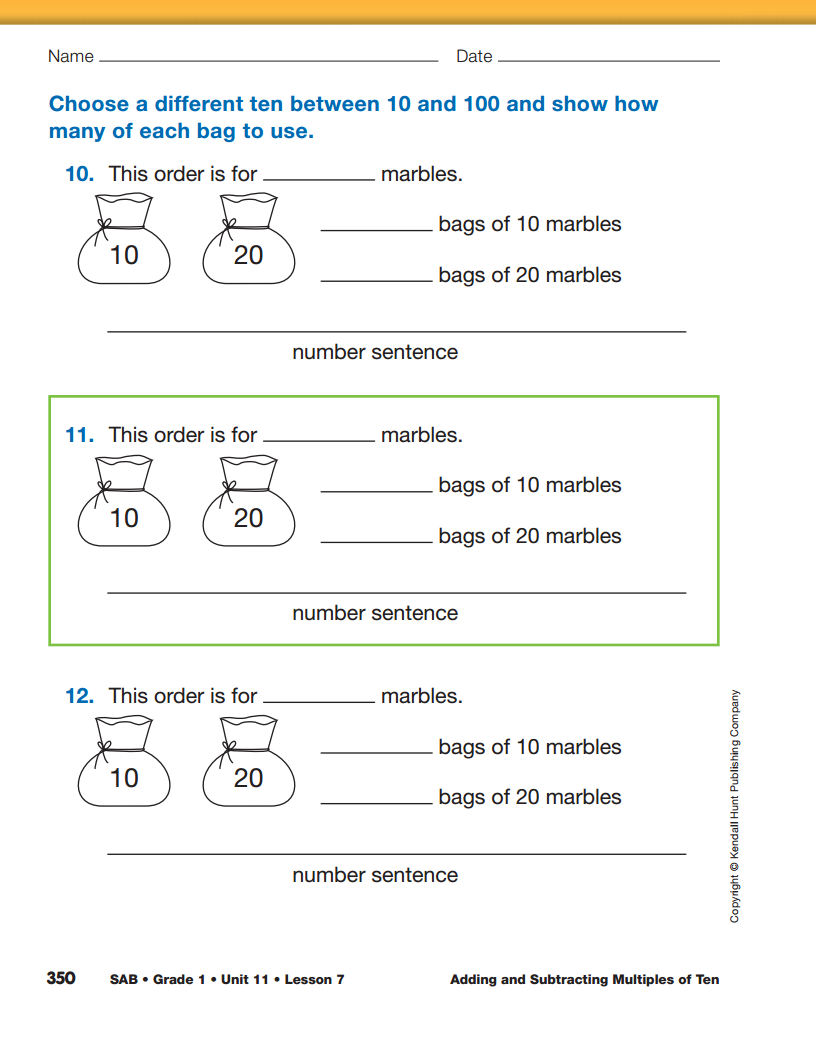Review Addition Strategies. Display ten trains of
ten connecting cubes and ask students to count them
by tens with you. Then put three trains together so
that you have a single train of 30 cubes. Make
another single train of 20 cubes. Tell students you
are adding the two together as you join them to make
one long train.
- How many cubes do I have now in one long
train? (50)
- What is the number sentence for what I just did?
(30 + 20 = 50)
Display the number sentence. Tell students you want
them to think of all the different ways they could
figure out how many total cubes there are now.
See Figure 1. Make sure the discussion includes the
following and ask students to demonstrate:
- Skip counting by tens from 30: 40, 50
- Three full ten frames plus 2 full ten frames equals 5 full ten frames
- Looking at the 100 Chart: start at 30 and count ten more twice
- Looking on the class number line: start at 30 and skip count by tens
- Counting all the cubes in the long chain
Add Multiples of Ten. Display the problem 30 + 20 = 50.
- Does this problem remind you of an easier addition
problem? (Possible response: 30 + 20 is like
3 + 2.)
- Can you use what you know about 3 + 2 to help
you solve 30 + 20? (Possible response: Yes, since
I know that 3 + 2 = 5, I know that
3 tens + 2 tens = 5 tens.
5 tens is the same
as 50.)
Students have already seen this connection, particularly
with their experience using chain links in
Lesson 2 and with the pennies and dimes on a ten
frame in Lesson 3. Pose a few more problems for
students to work on as practice.
- Maria owns a marble store. When she opened her
latest shipment of marbles from the warehouse,
she was surprised. Some of the sealed bags contained
10 marbles and some had 20. None of the
bags contained 30, 40, 50, or 60 marbles. Now,
Maria has a real problem: How is she going to fill
orders for more than 20 marbles? She needs our
help to fill her customers' orders.
Display and direct students' attention to Question 1
on the Marble Orders page in the Student Activity
Book.
- Maria's first order is for 70 marbles. How she can fill the order using the bags of 10 and 20 marbles?
Have connecting cubes, 100 Charts, and number
lines readily available. In addition, encourage students
to draw pictures. As students share ways of
obtaining 70 marbles using the bags of 10 and 20
marbles, write the number of each kind of bag and
the number sentence on the display. See Figure 2.
Encourage students to find other partitions of 70 and
to share their solutions. Have a volunteer verify each
solution by using the stacks of connecting cubes, a
number line, or a 100 Chart. See the Sample Dialog
for an example of a class discussion about solutions
for Question 1 on the Marble Orders page.

Use this Sample Dialog to discuss Question 1 on the Marble Orders page in the Student Activity Book.
Teacher: What is one way to fill the order for
70 marbles?
Maria: I used 7 bags of 10 marbles, so my number sentence
is 10 + 10 + 10 + 10 + 10 + 10 + 10 = 70. I skip
counted by tens to get to 70.
Teacher: Good answer, Maria! There are many ways we
can fill this order for 70 marbles. Who has a different
number sentence for this order?
Javier: I started with the bags of 20 and counted by 20s. I
had 3 bags of 20 and that equals 60 but I couldn't add
another bag of 20, so I added a bag of 10. My number
sentence is 20 + 20 + 20 + 10 = 70.
Teacher: That's great! Javier knew that he couldn't have
4 bags of 20 because that would make 80. He added
1 bag of 10 to the 3 bags of 20. Did someone else find
a different answer?
Grace: I got the same number sentence as Javier. I know that
2 + 2 + 2 + 1 = 7, so if I change the numbers to sets
of tens, my number sentence is 2 tens + 2 tens + 2
tens + 1 ten or 20 + 20 + 20 + 10 = 70.
Teacher: We have great thinkers in this classroom. Who
else used a different strategy?
Brandon: I started with 1 bag of 20 and I kept adding 10 on
the 100 Chart until I reached 70. I added 10 five times.
My number sentence is
20 + 10 + 10 + 10 + 10 + 10 = 70.
Teacher: That's another good strategy! Does anyone else
have a different number sentence?
Nila: I used connecting cubes and started with 3 trains of
20
and 1 train of 10. I already had the number sentence
20 + 20 + 20 + 10 = 70, so I broke apart one train of
20 into 2 trains of 10 and I got the number sentence
20 + 20 + 10 + 10 + 10 = 70.
Have student pairs work on the remaining orders on
the Marble Orders page. For Questions 1–3, students
write the numbers of bags of 10 and 20 marbles
and a number sentence to show one way to fill
the order. For Questions 4–9, explain that numbers
are repeated so that students can find two different
ways to fill each order. For Questions 10–12, students
select a multiple of 10 that was not used in
Questions 1–9.
Upon completion, have the class help you list various
ways to fill each customer order and demonstrate
how they used the number line, 100 Chart, or
connecting cubes to find the answer.
- How did you fill the order for 50 marbles? Talk
about any tools or strategies you used. (Possible
response: I thought of 5 ten frames: 10, 20, 30,
40, 50, so 5 bags of 10 marbles.
10 + 10 + 10 + 10 + 10 = 50.)
- What is another way to fill the order? (I started
with a bag of 20 in mind so I started on 20 on the
number line. Then I hopped by tens until 1 got to
50.
20 + 10 + 10 + 10 = 50.)
- How did you fill the order for 10 marbles?
(Possible response: I just used one bag of ten
marbles. I didn't need any bags of 20.)
- How does your number sentence show that you
didn't use any bags of 20? (Possible response:
10
+ 0 = 10. The 0 represents the 20-marble bag.)



















